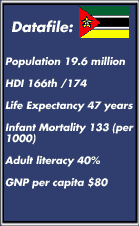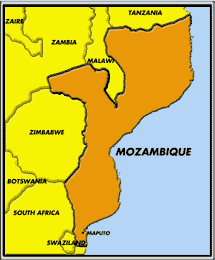
 Mozambique
Already one of the world's poorest countries, the war brought farming to a standstill and destroyed schools, health centres and most other facilities. Violence, torture and summary executions were commonplace. More than a third of the 17 million population fled their homes either to remote parts of Mozambique or into the neighbouring countries of Tanzania, Malawi, Zambia, Zimbabwe, South Africa and Swaziland. It wasn't until October 1992 that a peace treaty was signed and the civil war ended, leaving behind a decimated country where families had fought each other. A UN peace-keeping force was sent to Mozambique and UNHCR began a programme of repatriation.
UNHCR started an ambitious help project to try to speed up reintegration and rebuilding. It:
Some QIPs in Mozambique were not completed by the time UNHCR withdrew and handed them over in 1996. About 50% of the QIPs have been successful, including the provision of water pumps, health centres and schools. UNHCR's reintegration strategy was criticised by some NGOs. They felt that some of the QIPs had not been properly assessed, and that UNHCR were ignoring their expertise and experience in Mozambique. However, UNHCR regard their reintegration programme in Mozambique as one of their most successful ever. Some people think that much of this would have happened anyway, others disagree. It has helped people ask important questions about reintegration, and what lessons can be learned and applied to other refugee crises. A common problem is knowing when to withdraw help and support, and what happens to individual projects when they are handed over. Despite the successful return of so many people and the desire to rebuild, Mozambique remains one of the world's least developed countries. It achieved one of the highest economic growth rates (8%) in Africa in 1997 and the land has great potential for agricultural development. Yet the civil war left hundreds of thousands of landmines scattered across the country and El Nino brought severe flooding in 1997, ruining crops, whilst other areas suffered from drought. |
